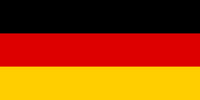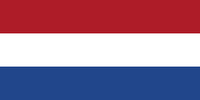The flour mill of Grolloo
Source:
- the New Drenthe Almanac, 1992, W.Houtman
- various newspapers
- milldatabase.org
- and from tradition
If you would like a translation of the text of the tablet, click on the image.
Corn mill of Bos
| Name | Korenmolen van Bos |
| Location | West side of the village |
| Place | Grolloo |
| Built in | 1852 |
| Gone | 1920/21 demolished |
| Type | Ground sailer |
| Drive | Windmill |
| Function | Corn mill |
In 1844 H. Brookman, corn miller's assistant in Assen, addressed the Governor with the request to grant him permission to set up a corn and hulling mill in Grolloo. As a place for the mill, he had chosen a high court near the Westersche Zand van Grolloo. Owned by the boermarke van Grolloo, located 280 meters from Jan Westebring's farm and 400 meters from the public road. Westebring was positive about it, the boermarke wanted to give up the land for free and the inhabitants of Grollo saw a lot of "driving and convenience" in it. The possibility of peeling was also considered important, because the residents thought they would make a lot of use of it. Despite the unanimously favorable advice of the mayor, the application was rejected. Brookman apparently did not leave it at that, because the mayor was asked for advice on two occasions afterwards. He pointed out that Grolloo had 266 souls (44 households) and Schoonloo 85 (13 households), that these places were respectively one and two hours' drive from the windmills of Rolde, and that a bread baker had already reported, who wanted to settle in Grolloo if a mill were to be built there. To no avail, the answer remained negative. In desperation, Brookman turned to the Provincial Council with a complaint that the Treasury Department had repeatedly rejected his applications for a license without reasons or grounds for the rejection being made known. The committee appointed from Parliament, which was to advise on this matter, reported after just one day that it considered it objectionable to issue a specific advice and again proposed to hand over the matter to the Provincial Executive. This Board would then have to decide or act 'as they think they should'. Brookman's mill was never built. But why not has remained unclear.
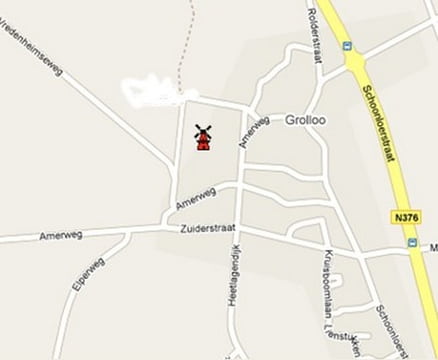
The location of the mill according to http://www.molendatabase.org

Position of the corn mill K.M. according to Bonne Bladen (1900-1930)

The flour mill of Grolloo, drawn by Ronnie Bügel
Entered by Bas Luinge
In 1849 Albert Bos, carpenter in Paterswolde, submitted a request to build a corn and chikorij mill in Grolloo. He had in mind a piece of heath west of the Grolloo - Amen road, owned by the Marke van Grolloo. The mayor, who again had to give advice this time, reported that the mill would be built a hundred meters from the public road and that the mill's rods would rotate above the span, so that there would be no danger to third parties. The old arguments in favor of building a mill were put forward again. This time it was added that the distance to Rolde led some to decide to feed the grain unground to the pigs and cattle. He also pointed out that more than one mill had already been built in Smilde, Westerbork, Borger, Odoorn, Ruinerwold, Eelde and Rolde. Then one mill was not too much to ask for Rolde. The Inspector of Taxes was not convinced and again inquired about the likelihood that the residents of Amen would have their grain ground in Grolloo, the distance and the condition of the road. Despite all the positive letters, the Ministry of Finance ruled against Bos' application.
18510815 newspaper PDAC windmill Bos

However, it was not left at that, with the result that in October 1852 a notification was issued by the Minister of Finance that, on behalf of the King, he granted A. Bos a permit to erect a windmill on condition that it was not closer than a hundred meters from the public road and construction was to take place within a year.
18521027 newspaper NieuweDrentschecourant windmill Bos

It is not possible to determine exactly when the mill was completed, but from the expiration of a twenty-year term of exemption from land tax on January 1, 1873, it can be deduced that the mill must have been there at the beginning of 1853. The mill was built on heathland of the undivided Marke van Grolloo, located west of the then road from the Pol in Grolloo to Amen. In 1854, a separate cadastral parcel was formed, comprising corn mill and yard, but this was first assigned to Bos in the mark division of 1856.
18530413 newspaper NieuweDrentsecourant windmill Bos laying the first stone
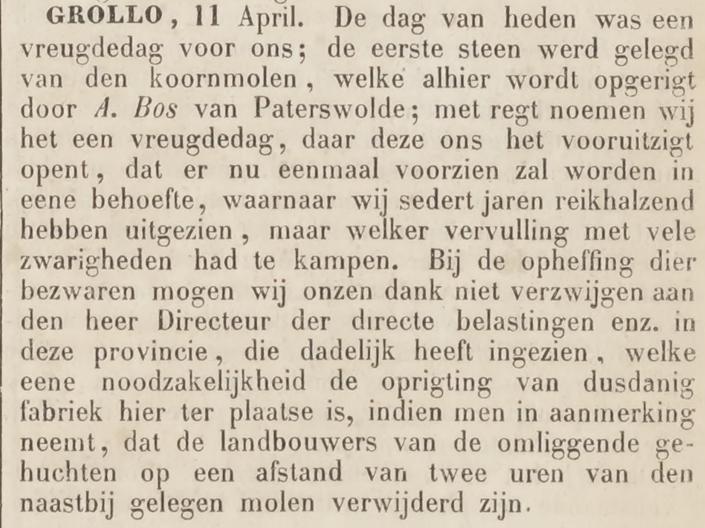
18530713 newspaper PDAC mill permit
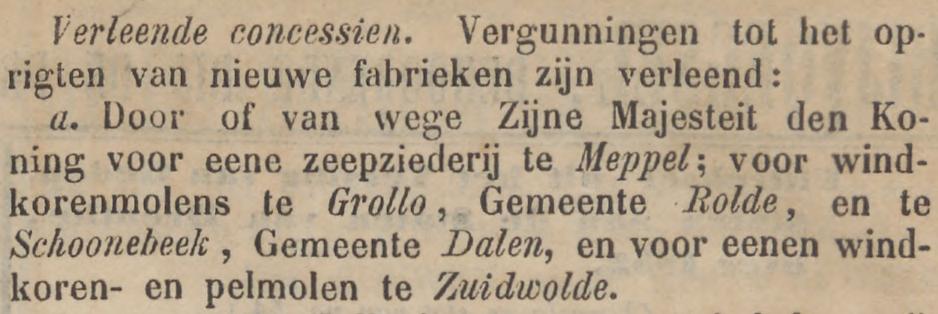
18531130 newspaper PDAC windmill sale Bos Eelde
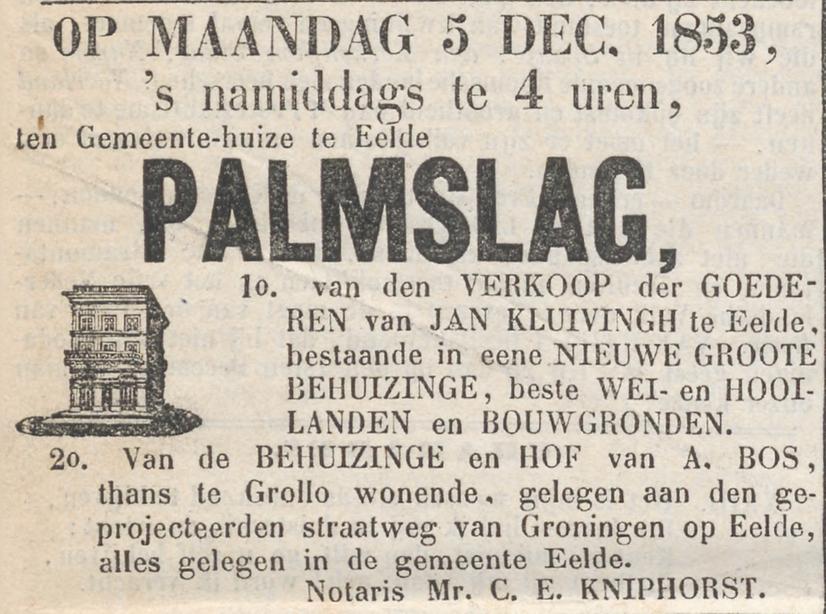
The further developments in chronological order are as follows:
- 1854: creation of kad. plot E 710, corn mill and yard, size 30 approx. the Markmates of Grolloo
- 1856: Perc. E 710 is at the Marke division no. E 929, moolen, 30 approx. In the name of A. Bos, moolenaar in Grollo
- 1867: Advertisement to be sold to the public on March 2, a well-maintained customer corn and hulling mill. Advertisement that on March 16, finally and at the stroke of the palm of your hand, "a well-maintained and customer-driven new stone corn and pelting mill, the only one in that church village, with adjacent land, has been sold at fl. 3650.
- 1867: sale to Arend Smit, farmer, Grollo
18670216 newspaper PDAC sale mill Bos
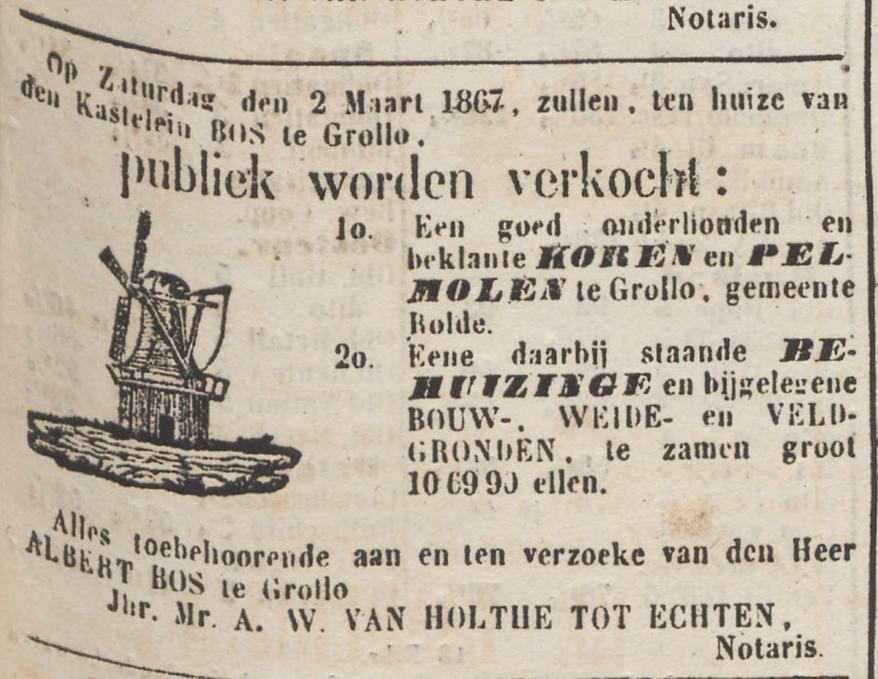
18670305 newspaper PDAC sale windmill and bakery Bos
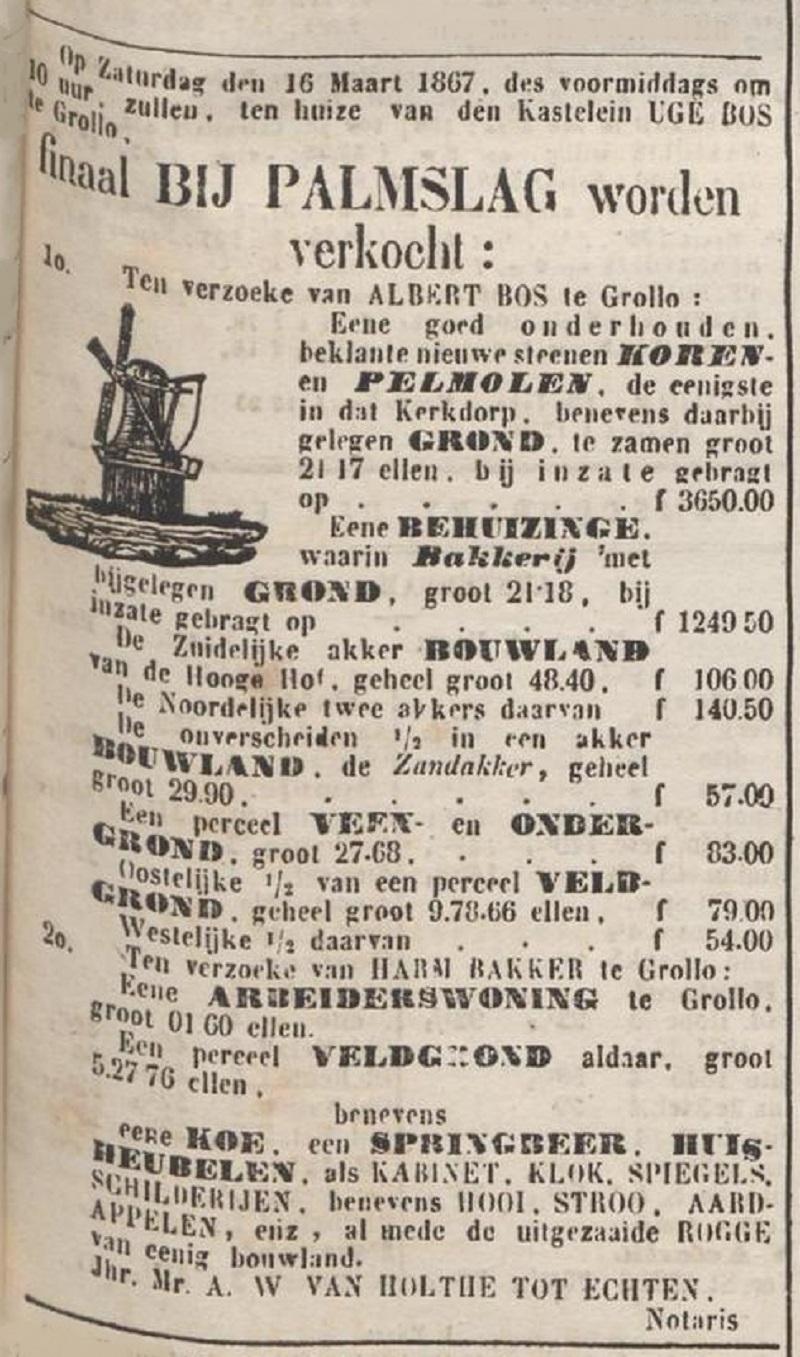
18670309 newspaper PDAC sale mill bakery Bos farm Bakker
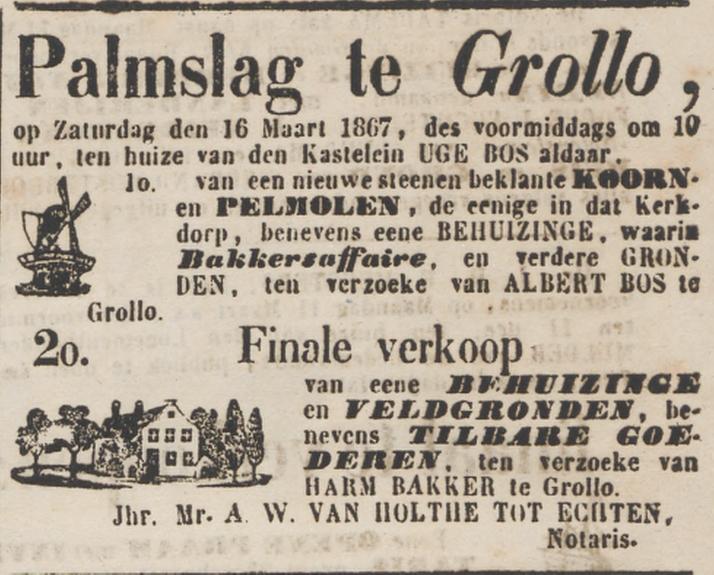
18670615 newspaper PDAC sale windmill bakery Bos
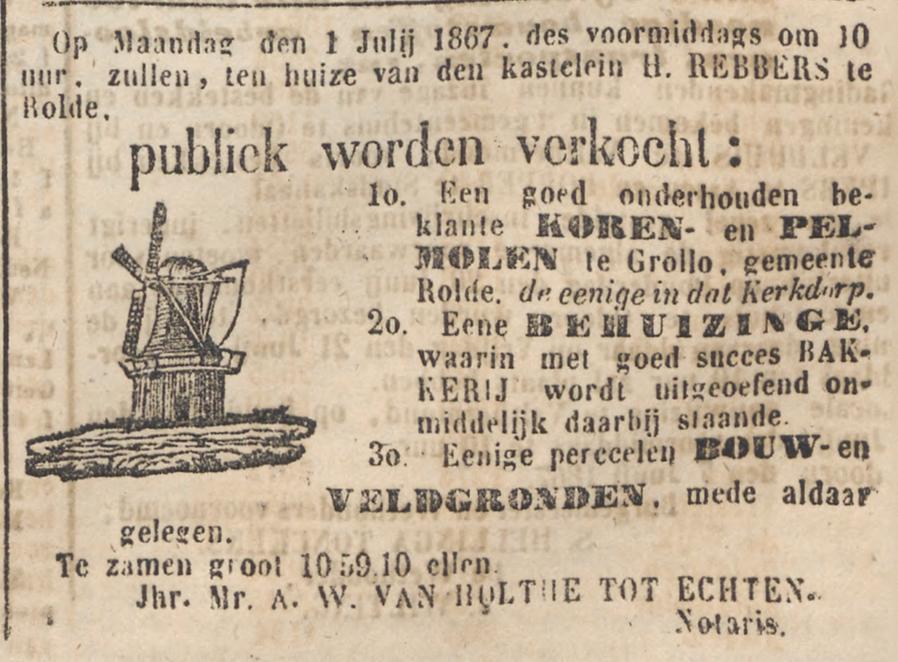
18670706 newspaper PDAC sale windmill bakery Bos
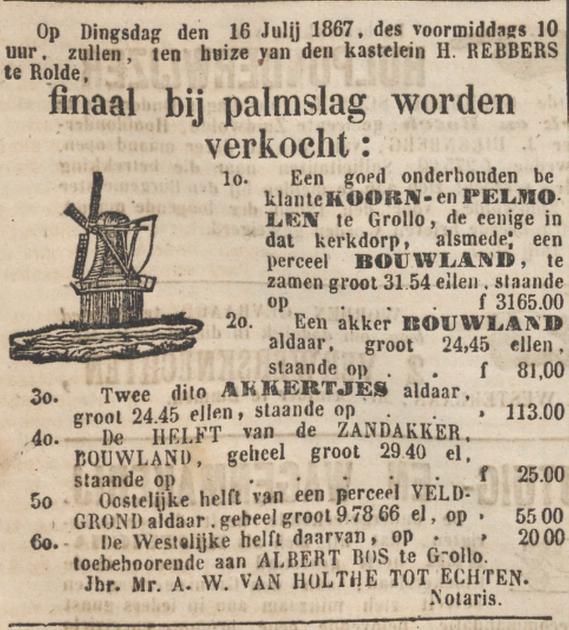
18670712 newspaper Leeuwarder Courant corn and peeling mill for sale
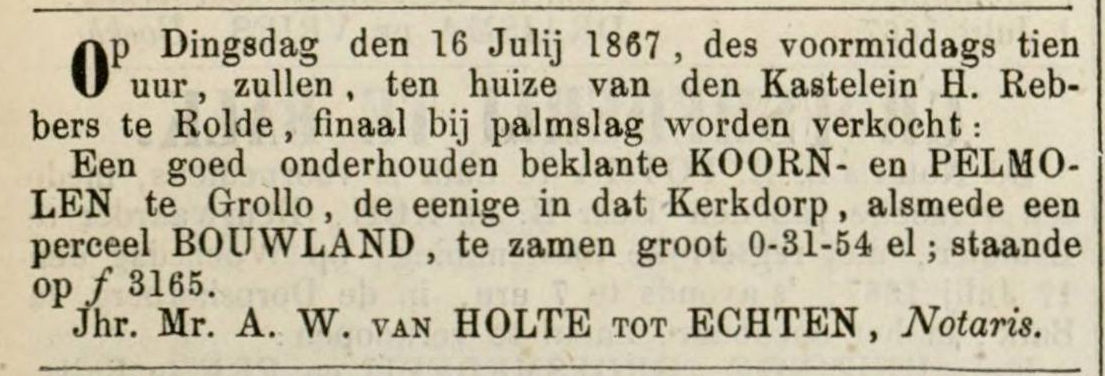
18671123 newspaper PDAC sale house Bos
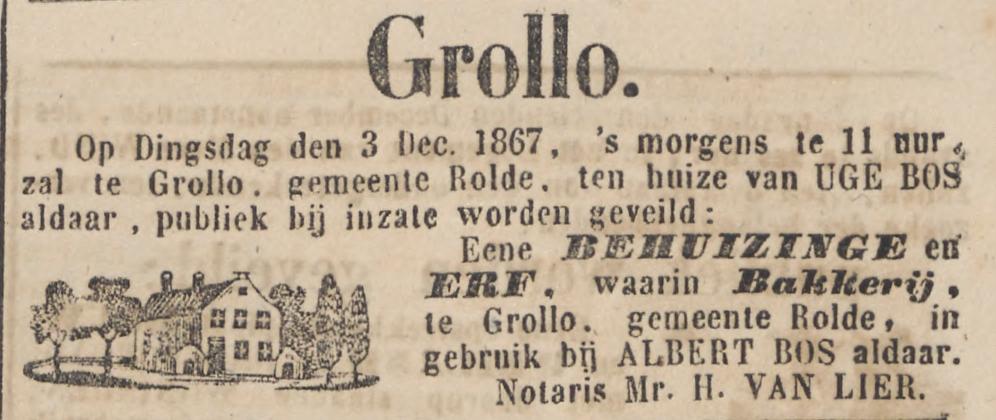
18680222 newspaper PDAC sale Uge Bos
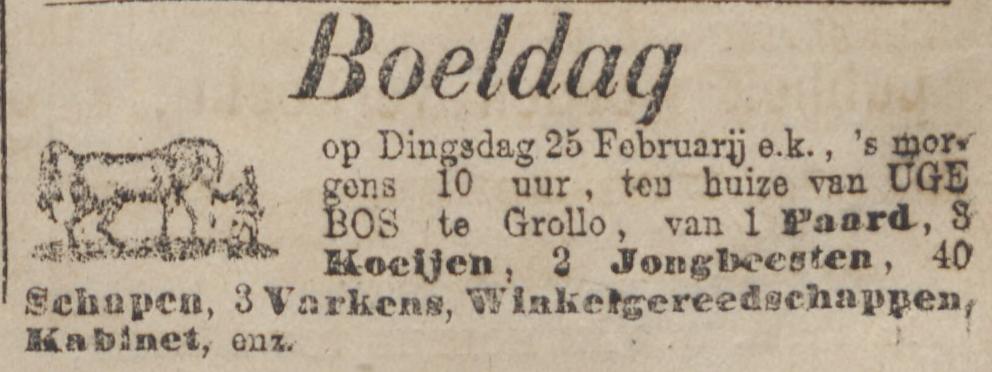
- 1868: sale to Hendrik Westerling, miller, Grollo
18680225 newspaper PDAC mill servant tools Westerling
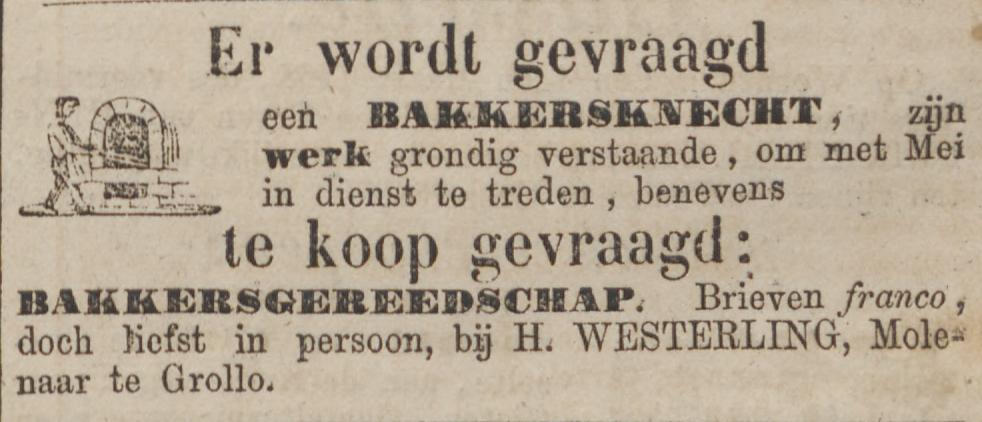
- 1876: sale to Bastiaan Haange, alderman, Rolde
- 1877: due to remeasurement perc. E 929 changed to O 165, wind corn mill, 30 ca.
- 1884: due to inheritance, the mill was named Willem Haange and cons, Bakker, Rolde
18720123 newspaper PDAC for sale bakery inn shop
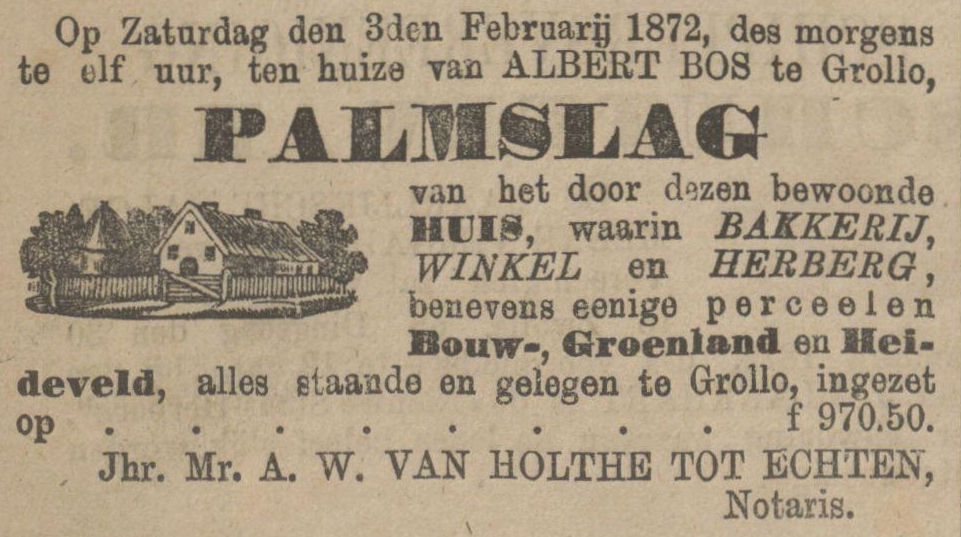
- 1922: In the deed of separation of the estate of the late Roelof Luinge (deceased 05/08/'22) perc. O 165 assigned to his son Bastiaan luinge, miller, Grollo, m. with L. Sibring. It is striking that the deed no longer mentions a mill.
- 1924: due to inheritance perc. O 165 in the name of Bastiaan and his children Aaltje and Sikko (born 1917)
- 1950: Not until this year, when the plot was in the name of L. Geerlig - Sijbring, previously wed. van B. Luinge, the mill was cleaned from the cadastral map and the 'taxable revenue built' for the mill from the quay. shelf removed. As a result, until 1950, land tax for the mill still had to be paid.
The mill was actually demolished in 1920 or 1921 by the well-known windmill builder Vlieghuis from Borger. He also always took care of the maintenance. The mill was of the ground mill type and relatively small. In the last years, after 1914, he played only occasionally. The reason for this was that in 1914 it was decided to build a steam dairy factory as a successor to the hand power factory and also to connect a flour mill to it. By deed of March 25, 1914, the 'Cooperative Stoomzuivelfabriek en Korenmaalderij Vooruitgang Zij Ons Doel' (V.Z.O.D.) was established. Bastiaan Luinge was then appointed as permanent mulder. The road from the Amerweg along the north side of the mill was called the Meulendiekie. It was later purchased by Hendrik Hadders who produced it on his land. A millstone by Sikko Luinge on the Amerweg in Grolloo is now the only tangible reminder of the flour mill of Grolloo.
.

The millstone of the wind horn mill of Grolloo, owned by the Luinge family until about 1920, has graced the front garden of Sikko Luinge and Roelfien Hebels in Grolloo for many years. (photo Geert Kamphuis)
According to the books of Wouda, sailmaker in Meppel, the mill rented the sails from 1876 to 1917, sails of 68 feet were rented. The Amsterdam base was probably used here in Drenthe, which is over 28 cm. other sizes are the Utrecht city foot (26.8 cm). The Frisian king's foot (32.6 cm), the later Frisian or Deventer wood foot (29.5 cm)

